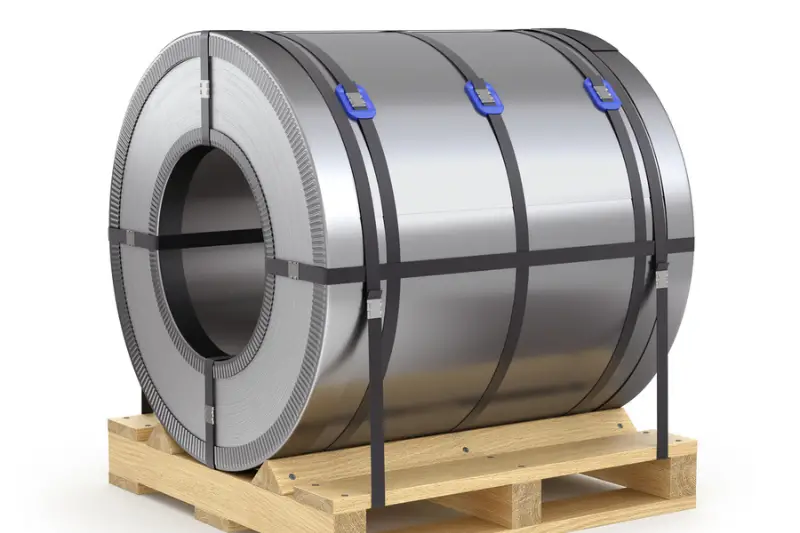Click here to get this post in PDF
Do you need steel strapping? With so many different varieties of strapping available today, it’s difficult to choose the best type for your application. You may wonder whether metal strapping or steel strapping has been superseded by something better.
As its name suggests, “steel strapping” is strap made of different kinds of steel alloys. Which type of steel strapping you choose for an application depends on your requirements.
For example, standard steel strapping is made of alloys containing varying amounts of carbon: it’s used for many applications. On the other hand, stainless steel strapping is made of an alloy containing chromium: it’s highly resistant to corrosion, making it suitable for valuable loads exposed to moisture and weather.
Let’s look at the benefits of using steel strapping in your applications.
Steel strapping: the benefits of using steel or stainless steel strapping
Used in situations where maximum strength and minimal stretch are required, steel strapping offers two major benefits:
- Strength and reliability—it’s relied on in heavy industries like mining;
- High performance in many different environments, and under many challenging conditions.
Let’s look at the benefits in more detail.
Steel strapping: tough, strong, and reliable
Whatever your needs, you’re likely to find steel strapping that’s right for your application. Not only is steel strapping available in many widths and diameters, it’s also available in various grades and prices.
It can be used to secure smaller items like bundles of newspapers for shipping, as well as in securing heavy loads on trucks, in shipping containers, and in railway box cars.
Steel strapping performs a protective function too, such as in the construction industry, where it’s used to stabilize and secure fragile glass sheets and tiles during shipping.
All steel strapping has a high tensile strength (that is, a high resistance to snapping and breakage.) This makes steel strapping ideal for industries such as shipping, construction, and mining.
Consider this type of metal strapping in situations in which you need:
- The ability to strap and control loads which are not only large, but also heavy, such as big metal or cement pipes for example.
- To ship loads across the country, or across the globe, so that loads will maintain their integrity when handled many times.
- To manage sharp-edged, awkwardly-shaped, heavy loads.
Need ultra high tensile steel strapping?
For situations which require the highest tensile strength possible, steel strapping is also available as “high tensile steel strapping”.
This type of metal strapping is made of steel alloys specifically developed for increased strength and reliability, where strapping failure isn’t an option. Strapping labelled high tensile steel strapping is used in heavy industry. The alloys used may contain metals like nickel and chromium.
Steel strapping ensures high performance in challenging conditions and environments
Aside from its strength, the major benefit of choosing steel strapping is that it will perform in the most challenging conditions, as well as in challenging environments.
Challenging conditions may include:
- Extremes of heat and cold;
- Weather extremes;
- Constant vibration or repeated shocks;
- Corrosion;
- Radiation.
Since it meets challenging conditions, steel strapping is used in challenging environments, including:
- Oil refineries;
- Chemical and treatment plants;
- Nuclear plants;
- Ships and submarines;
- Wind farms.
If you’re looking for strapping which is suited to harsh environments, choose a grade of steel strapping which meets your needs and is cost-effective too.
For example, you may consider heat-treated carbon steel strapping. Not only is it heat resistant, it’s shock-resistant too. The heat tempering treatment increases the steel’s strength, as well as its ability to perform even when subjected to high temperatures and repeated shocks.
Choosing the correct type of steel strapping for a specific application is challenging: you may need advice.
Steel strapping and the environment: is it sustainable?
When considering sustainability, steel strapping has a major benefit: it can be recycled again and again.
It’s estimated that some 80% of “new” steel products are made from recycled steel.
Your challenges when using steel strapping
Although steel strapping has superior benefits, it has challenges too.
Worker safety is the major challenge. When under tension, if steel strapping snaps, the recoil is dangerous and causes injuries. It’s essential to ensure that operators (and other people nearby) not only wear gloves and reinforced boots, but also wear goggles or safety helmets to protect their eyes.
Do you need advice on steel strapping?
Unsure of which type of steel strapping you should choose?
It’s vital to consider the break strength of your chosen strapping. You need strapping which is more than strong enough to handle your application. However, choosing a higher grade of steel strapping than you need is wasteful.
Get advice from reputable packaging suppliers who can help you understand the best options for your needs.
About the Author
Gateway Packaging sources the most innovative packaging supplies from across the world to give excellent packaging supplies and solutions that are both cost-effective and efficient to Australian manufacturers.
You may also like: The Best Testing Methods to Check the Packaging Quality & Strength
Image source: Depositphotos.com


